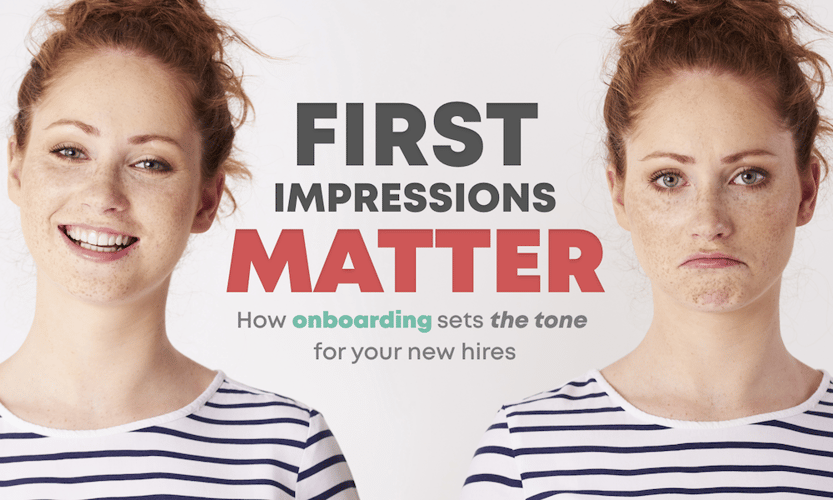Onboarding a new employee should be about more than just obligatory paperwork. Your onboarding process should also inform your new employee of your company’s people, culture and values. After all it is the first real impression you will give them as a company, so don’t make the mistake of making it all about requirements.
In this blog, I outline what you need in an employee onboarding pack and what you should consider adding to create a more personal and informative employee onboarding experience that is sure to make a good first impression.
Must have items
These are mandatory or highly encouraged forms that most companies will be required to include in their onboarding packs, though of course the exact forms may vary from region to region.
The contract
The most important document to include in an employee onboarding pack is their employment contract. An employment contract outlines the new employee’s responsibilities within their new role and puts into writing their remuneration offer.
The most efficient way to send out these contracts is using an auto-generating onboarding PDF . These documents use merge tags to pre-populate themselves with the relevant and accurate information you gathered during recruitment.
Tax forms
A must for any onboarding pack is your country’s tax form/s. These forms vary from country to country and even state to state, so be careful to include all your necessary form/s.
TFN declaration form (AUS)
This form is a must for any Australian company as it is where employees can declare their tax file number (TFN). Employees need to declare their TFN so the Australian Taxation Office (ATO) can determine the amount of tax that should be withheld based on the employee’s income.
If this form is not given to a new employee, they cannot declare their TFN, and as a result, their tax will be withheld at the highest marginal tax rate – no one wants that.
W-4 form (US)
Similarly, the W-4 form is a must for any US company to include in their onboarding pack. This form is used to determine how much of an employee’s pay should be withheld each pay for federal income taxes and sent to the Internal Revenue Service (IRS). This form helps ensure that your employee will be paying a suitable amount of tax throughout the year – so that come tax time, they won’t owe a large sum or realise they have been overpaying throughout the year.
Employment Eligibility Verification
All employers have an obligation to ensure their employees have the legal right to work in the country. Failure to do so can result in serious consequences for your organisation.
In the US, employees must complete the I-9 form, while in AUS, you must ask for a certified copy of a right-to-work document.
I-9 form (US)
The I-9 form is used to verify the work eligibility of new employees. All employers in the US are legally required to verify their potential employee’s identity and authority to work in the country. However, this is only allowed to be done after the candidate has been offered the position. This is done to try and prevent discrimination in the hiring process.
Companies must comply with the I-9 retention and completion rules as failure to do so could result in severe fines for the organisation.
Proof of Right to Work Document (AUS)
Similarly, in Australia, you are obligated to verify the work eligibility of your employees. To do so, you must obtain a certified copy of an original right-to-work document or have the original certified by someone authorised (like a Justice of the Peace).
Additionally, you must keep these documents on record.
The acceptable right-to-work documents are:
Australian birth certificate
Australian citizenship certificate
Australian passport
New Zealand passport
Evidence of permanent residence
Certificate of Status for New Zealand Citizens in Australia and photo identification
Valid visa with permission to work
Super choice form (AUS)
Australian employers need to ask new employees to nominate their super fund of choice so that employers may make the necessary contributions to the employee’s super fund.
The form is twofold. Employers need to complete a section of the form with details of their default fund before giving the form to the employee to complete. Employees will then nominate their super fund or select your default fund.
Keep in mind that there are new rules surrounding if your employee fails to choose a super fund which will add a further step to your onboarding process.
Fair Work Information Statement (AUS)
This is another must-have document that is only applicable to Australian employers. The Fair Work Information Statement (FWIS), is a mandatory document that employers must give to their employees before they start their employment or as soon as possible after. If the employee is being hired on a casual basis, they must also receive a copy of the Casual Employment Information Statement (CEIS).
Direct deposit form
A pretty obvious one that has to be included in this list is a direct deposit or banking details form. Your new employee may be a bit hesitant to start a new role knowing that you have none of the details to pay them – so this is a definite must-include for all.
Ensure that you are including this form, and any additional information your payroll team may need to be ready for your employee from their very first day.
Recommended items
These are the items I recommend including in an employee onboarding pack to help to better their employee onboarding experience and create a more personable onboarding experience that is sure to make a good first impression.
Emergency contact form
You hate to think after taking every precaution to prevent emergencies from happening that they would still occur, but the truth is emergencies are often out of our control. So, You must be prepared and equipped to handle them.
Any number of things could happen for example:
The employee has not shown up for work and is not answering their phone
The employee is sick or has a medical emergency at work
There is an accident involving the employee
Why is this important to include?
Having at least one emergency contact for each employee will cover your bases in the event of an emergency like the ones mentioned above.
Welcome video
Creating a welcome video for new employees is a fantastic way to showcase your company’s personality, culture and employees. What’s more, a good welcome video does not have to be high production quality, a simple video with minimal editing can give an air of authenticity that high production just can’t.
Why is this important to include?
A welcome video may help to relieve some of the anxieties a new employee may have about starting at a new company. Introducing friendly faces they will encounter once they commence, showing them around the office virtually or even just saying congratulations can go a long way to ease a new employee’s nerves.
Org chart overview or segment
You should also consider including an org chart or org chart segment as a part of your initial onboarding pack as it will help new employees to better understand your organisation’s structure. It will also be able to act as a resource for your employees to look back on should they need to see reporting lines, names, position titles etc.
Why is this important to include?
Starting a new job can be nerve-racking – mainly because so much is unknown. If you as the employer can shed more light on some of these unknowns it can go a long way to reduce anxieties about starting.
General first-day information
Another important thing to consider including to help reduce anxieties about starting a new role is an information sheet specifically devoted to general first-day information. Everything an employee has to know to get through their first day smoothly, comfortably and without worry.
Include things such as:
A map of the building &/or the area
Parking in the area
Public transport options nearby
A few of the local favourite coffee shops or cafes
First-day itinerary ie. tour, meet the team, training, set-up etc.
What break room facilities are available for them to use
Why is this important to include?
Every new employee will have questions in the lead-up to starting with an organisation. While they may go and do their own research to answer some of these questions – many cannot be answered by anyone but the employer. To preemptively answer these questions, shows a real sense of initiative and care.
Code of conduct
If you have a workplace code of conduct in place in your organisation, it is useful to include it in your initial employee onboarding pack. It will help to ensure your new employees are aware of your expectations of staff and therefore will help to prevent any future inappropriate behaviour.
Why is this important to include?
You want your employees to acknowledge the document to show that they understand the perimeters of the agreement, and the best way to do this is in your digital onboarding pack.
Conclusion
Onboarding packs need to be informative, personable and compliant. It is easy to get stuck on just making sure they are compliant, but it is important to remember onboarding is about more than just giving and receiving required documents.
A good onboarding pack should focus on providing your new employee with information but also teaching them about your company’s people, culture and values. Shifting your focus beyond just compliance documents will go a long way to reduce new employees’ anxieties and create a good onboarding experience that is sure to make a good first impression.
Learn more about onboarding best practices in our upcoming webinar ‘Employee Onboarding Tech & HR Best Practices’, US/UK/CA HERE & AUS/NZ HERE.





Blog comments